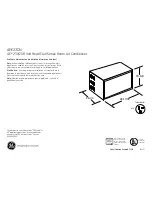
5284792-UIM-A-0317
Johnson Controls Unitary Products
5
PRECAUTIONS DURING LINE INSTALLATION
Install the refrigerant lines with as few bends as possible. Care must be
taken not to damage the couplings or kink the tubing. Use clean hard
drawn copper tubing where no appreciable amount of bending around
obstruction is necessary. If soft copper must be used, care must be
taken to avoid sharp bends which may cause a restriction.
1. The lines should be installed so that they will not obstruct service
access to the coil, air handling system, or filter.
2. Care must also be taken to isolate the refrigerant lines to minimize
noise transmission from the equipment to the structure.
3. The vapor line must be insulated with a minimum of 1/2” foam rub-
ber insulation (Armaflex or equivalent). Liquid lines that will be
exposed to direct sunlight, high temperatures, or excessive humidity
must also be insulated.
4. Tape and suspend the refrigerant lines as shown. DO NOT allow
tube metal-to-metal contact. See Figure 7.
5. Use PVC piping as a conduit for all underground installations as
shown in Figure 4. Buried lines should be kept as short as possible
to minimize the build up of liquid refrigerant in the vapor line during
long periods of shutdown.
6. Pack fiberglass insulation and a sealing material such as permagum
around refrigerant lines where they penetrate a wall to reduce vibra-
tion and to retain some flexibility.
PRECAUTIONS DURING BRAZING OF LINES
All outdoor unit and evaporator coil connections are copper-to-copper
and should be brazed with a phosphorous-copper alloy material such
as Silfos-5, silver solder or equivalent. DO NOT use soft solder. The
outdoor units have reusable service valves on both the liquid and vapor
connections. The system refrigerant charge for 15 feet of lineset is
retained within the outdoor unit during shipping and installation. The
reusable service valves are provided to evacuate and charge per this
instruction.
Serious service problems can be avoided by taking adequate precau-
tions to assure an internally clean and dry system.
PRECAUTIONS DURING BRAZING SERVICE VALVE
Precautions should be taken to prevent heat damage to service valve
by wrapping a wet rag around it as shown in Figure 5. Also, protect all
painted surfaces, insulation, and plastic base during brazing. After braz-
ing, cool joint with wet rag.
Valve can be opened by removing the service valve cap and fully insert-
ing a hex wrench into the stem and backing out counter-clockwise until
valve stem just touches the chamfered retaining wall.
Connect the refrigerant lines using the following procedure:
1. Remove the cap and Schrader core from both the liquid and vapor
service valve service ports at the outdoor unit. Connect low pres-
sure nitrogen to the liquid line service port, allow nitrogen to flow.
2. Braze the liquid line to the liquid service valve at the outdoor unit. Be
sure to wrap the valve body with a wet rag. Allow the nitrogen to
continue flowing.
3. Carefully remove the plugs from the evaporator liquid and vapor
connections at the indoor coil.
FIGURE 3:
Installation of Vapor Line
FIGURE 4:
Underground Installation
Liquid
Line
Incorrect
Correct
Tape
Sheet Metal Hanger
Insulated Vapor Line
A0151-001
TO INDOOR COIL
TO OUTDOOR UNIT
LIQUID LINE
CAP
PVC
CONDUIT
INSULATED
VAPOR LINE
A0152-001
CAUTION
Dry nitrogen should always be supplied through the tubing while it is
being brazed, because the temperature required is high enough to
cause oxidation of the copper unless an inert atmosphere is provided.
The flow of dry nitrogen should continue until the joint has cooled.
Always use a pressure regulator and safety valve to insure that only
low pressure dry nitrogen is introduced into the tubing. Only a small
flow is necessary to displace air and prevent oxidation.
CAUTION
The EEV is factory installed but shipped in the closed position.
Prior to any brazing, power must be applied to the Indoor Unit. If
installing a coil furnace match or multi-piece air handler system,
the EEV harness must be plugged into the Comm port prior to
applying power to the indoor unit. Allow
1 minute
for the EEV to
open to allow proper nitrogen flow through the coil and lineset.
WARNING
This is not a backseating valve. The service access port has a valve
core. Opening or closing valve does not close service access port.
If the valve stem is backed out past the chamfered retaining wall, the
O-ring can be damaged causing leakage or system pressure could
force the valve stem out of the valve body possibly causing personal
injury.
FIGURE 5:
Heat Protection
!
!
!
$
:(75$*6
:UDSZHWUDJV
DURXQGVHUYLFHYDOYH
RUUHIULJHUDQWOLQHV
SULRUWREUD]LQJ






































